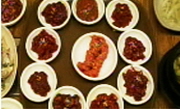이 글은 박경리 『토지』와 신동엽 『금강』에 나타난 동학 담론의 특징과 의미를 비교 분석하였다. 박경리와 신동엽은 모두 일제시대에 태어나 청소년기를 보냈으며, 남북전쟁과 4.19라는 ...
http://chineseinput.net/에서 pinyin(병음)방식으로 중국어를 변환할 수 있습니다.
변환된 중국어를 복사하여 사용하시면 됩니다.
- 中文 을 입력하시려면 zhongwen을 입력하시고 space를누르시면됩니다.
- 北京 을 입력하시려면 beijing을 입력하시고 space를 누르시면 됩니다.
https://www.riss.kr/link?id=A107085881
-
저자
박상민 (강남대학교)
- 발행기관
- 학술지명
- 권호사항
-
발행연도
2017
-
작성언어
Korean
-
주제어
박경리 ; 토지 ; 신동엽 ; 금강 ; 장시(長詩) ; 동학 ; 동학농민운동 ; 동학 담론 ; 농민전쟁 ; 김개주 ; 신하늬 ; Kyeoni Park ; Toji ; Dongyeop Shin ; Geumgang ; long poetry ; Donghak ; Donghak Agrarian War ; Donghak discourse ; Gaeju Kim ; Hani Shin
-
등재정보
KCI등재
-
자료형태
학술저널
-
수록면
97-126(30쪽)
- 제공처
-
0
상세조회 -
0
다운로드
부가정보
국문 초록 (Abstract)
이 글은 박경리 『토지』와 신동엽 『금강』에 나타난 동학 담론의 특징과 의미를 비교 분석하였다. 박경리와 신동엽은 모두 일제시대에 태어나 청소년기를 보냈으며, 남북전쟁과 4.19라는 역사적 격변기를 경험하였다. 『토지』는 소설이고 『금강』은 시라고 하는 장르의 변별성이 분명하지만, 각 작품에서 다루고 있는 동학 담론의 특징을 비교하는 것은 두 작품의 주제와 의미를 더욱 온전하게 규명하는 연구이며, 동시에 갑오년 동학농민운동의 의미를 새롭게 환기하고 심화시키는 유의미한 작업이다. 『토지』는 김개주라는 역사적 실존 인물을 시원(始原)에 두고 그와 관련된 수많은 허구적 인물들을 그렸다. 이렇게 허구적 인물들이 서사의 중심에 들어오면 인물들의 성격과 행동은 자유로워질 수 있다. 한 명의 역사적 실존 인물을 중심으로 수많은 가상의 인물을 설정했던 『토지』와 달리 『금강』은 신하늬라는 허구적 작중 인물이 수많은 역사적 실존 인물들과 관련을 맺고 있다. 이러한 서술 방식은 이미 발생한 역사적 사실을 변경할 수 없기 때문에 인물들의 행위가 다소 제한적이다. 이처럼 『토지』와 『금강』은 서로 다른 전략을 택했기에 서로 다른 방식으로 동학을 말할 수밖에 없었지만 갑오년 농민운동의 의미를 재조명함으로써, 갑오년의 실패를 아쉬워하면서도 두 번 다시 실패를 되풀이하지 않으려는 민족적 소망을 효과적으로 형상화하였다
다국어 초록 (Multilingual Abstract)
This paper compared and analyzed the meanings of Donghak discourse in the Kyeongni Park's novel Toji and Dongyeop Shin’s long poetry Geumgang. Both writers were born in the era of Japanese colonial rule and had adolescence, and experienced the Yuk-i...
This paper compared and analyzed the meanings of Donghak discourse in the Kyeongni Park's novel Toji and Dongyeop Shin’s long poetry Geumgang. Both writers were born in the era of Japanese colonial rule and had adolescence, and experienced the Yuk-i-o(the Korea Civil War in 1951) and the April Revolution in 1960. Toji is a novel and Geumgang is a distinct genre. However, comparing the meanings of Donghak discourse covered in each work is a study that thoroughly identifies the theme and meaning of both works. At the same time, It is a meaningful work to renew and deepen the value. Toji created a number of fictional figures related to him, with Gaeju Kim being a historical figure. When these fictional characters enter the center of the narrative, the character and actions of the characters can be freed. Unlike Toji, who has set up a number of fictional figures around a single historical person, Geumgang has a fictional character named Hani Shin related to many historical figures. These narrative methods can not change the historical facts that have already occurred, so the behavior of the characters is limited. As Toji and Geumgang chose different strategies, they had to talk about Donghak in different ways, but by reexamining the significance of the Donghak Agrarian War, they effectively shaped the national desire not to repeat the failure again.
목차 (Table of Contents)
- 국문초록
- 1. 연구 목적 및 방법
- 2. 역사적 실존 인물을 둘러싼 허구적 인물들의 이야기: 『토지』의 동학 담론
- 3. 허구적 인물을 통해본 역사적 인물들의 이야기: 『금강』의 동학 담론
- 4. 농본적 아나키즘의 이상과 균열
- 국문초록
- 1. 연구 목적 및 방법
- 2. 역사적 실존 인물을 둘러싼 허구적 인물들의 이야기: 『토지』의 동학 담론
- 3. 허구적 인물을 통해본 역사적 인물들의 이야기: 『금강』의 동학 담론
- 4. 농본적 아나키즘의 이상과 균열
- 5. 결론
- 참고문헌
- Abstract
동일학술지(권/호) 다른 논문
-
금기된 과거사에 대한 여성의 기억과 의미- 여계(女系)전승 동학농민혁명담을 중심으로
- 동학학회
- 박상란
- 2017
- KCI등재
-
- 동학학회
- 지현배
- 2017
- KCI등재
-
- 동학학회
- 조극훈
- 2017
- KCI등재
-
- 동학학회
- 채길순
- 2017
- KCI등재





 eArticle
eArticle






